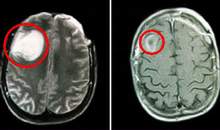Brain tumors are an abnormal growth of a type of nerve cell and rank second among cancers in children. The incidence of primary brain tumors is approximately 2-3 per 100,000 children, with a higher prevalence in boys than girls. This condition is dangerous and life-threatening for children, thus early detection is crucial for timely treatment.
Symptoms to Watch For
 |
|
Brain Tumors (Image: ND) |
Children may complain of headaches, nausea, and exhibit a staggering gait, walking quickly at times and slowly at others. They might have blurred vision, with distorted shapes appearing when they look at objects. Their temperament may change, becoming more withdrawn or aggressive, and they may frequently be irritable. When afflicted, children may experience poor growth with little or no weight gain and height increase. If they are in school, their academic performance may decline, and many parents, unaware of the illness, may attribute this to excessive play. Additionally, some children may experience speech distortions, suddenly developing stuttering or mispronouncing words. Fatigue and excessive drowsiness are also common symptoms.
Common Neurological Symptoms
A large head, bulging fontanelle, and cranial suture separation may indicate a problem. Symptoms may include optic disc edema, drooping eyelids, dilated pupils, asymmetric pupils, strabismus, and vision loss. Children may lose balance, coordination, and exhibit heightened reflexes. In many cases, they may suffer from facial nerve paralysis, hemiplegia, or paralysis of both lower limbs. Confusion, stupor, or coma can occur, and if a full examination is conducted, signs of poor growth, precocious or delayed puberty, and stiff neck may be observed.
Classification
Brain tumors are classified into two types: supratentorial tumors and infratentorial tumors. Depending on the tumor’s location, there are various clinical manifestations for supratentorial tumors:
* Cerebral Hemisphere Tumors: These tumors grow slowly and may only present with seizures or headaches initially. They are often discovered when the tumor size increases, causing increased intracranial pressure or uncontrollable seizures. If the tumor becomes too large and ruptures, it can lead to bleeding within the tumor, further escalating the acuteness and danger of the condition. Large tumors can also compress the brain, obstructing the flow of cerebrospinal fluid. Most of these tumors progress subacutely, with symptoms developing over months prior to diagnosis.
During examination, if the cranial sutures are widened, doctors can easily identify the presence of a large tumor. Tumors located deep in the frontal region are usually less malignant, developing slowly without causing serious brain dysfunction. The majority of cerebral hemisphere tumors are glial cell tumors: star-shaped with fewer tail-like projections.
* Craniopharyngiomas: These tumors develop in the pituitary gland area. Children with this type of tumor may experience vision loss due to optic nerve invasion and growth retardation due to pituitary damage. However, some children may only present with headaches.
* Optic Nerve Tumors: Found in neurofibromas, these glial cell tumors can lead to severe vision loss in children.
* Pineal Tumors: Children with this type of tumor often experience precocious puberty and symptoms of increased intracranial pressure.
* Third Ventricle Tumors: These tumors invade the hypothalamus and can present with seizures, episodes of laughter, precocious puberty, and behavioral disturbances.
* Thalamic Tumors: Clinical manifestations in these children may sometimes only include symptoms of increased intracranial pressure, headaches, and obesity.
For infratentorial tumors, the following types are included:
* Primitive Neuroectodermal Tumors (PNET): This is the most common type of tumor in children, developing in the cerebellar center and the floor of the fourth ventricle. It invades the fourth ventricle, obstructing cerebrospinal fluid flow, leading to early ventricular dilation. Children with this type of tumor may experience vomiting, headaches, cerebellar syndrome, personality changes, insomnia, and decreased muscle tone. This type of tumor can metastasize via the cerebrospinal fluid to the spinal cord.
* Cystic Astrocytomas: These tumors occur in the cerebellar hemisphere and are round, cystic tumors with mixed solid and cystic components. When they grow large, they can deform the cerebellum and the fourth ventricle.
* Brainstem Tumors: The onset of this type of tumor usually begins with paralysis of the sixth cranial nerve, followed by weakness of one side of the body. In some cases, children may develop difficulty speaking, stuttering, choking while drinking, and eventually weakness on the opposite side of the body. This is also a type of glial cell tumor that poses a significant risk to life, with a high mortality rate within six months, although survival may be prolonged if it is a neurofibroma.
The detection and diagnosis of the disease depend on the tumor’s location and characteristics. Common symptoms include increased intracranial pressure, headaches, vomiting, fatigue, mood changes, declining academic performance, seizures, and in small children, a large head. Examination of the fundus may reveal signs of optic disc edema.
Upon diagnosis, most cases require surgical intervention combined with chemotherapy and radiation therapy. During treatment, children should receive adequate nutrition, avoid stress, and be provided with a healthy, cheerful environment.
Associate Professor – Doctor Ninh Thi Ung – Central Children’s Hospital


















































